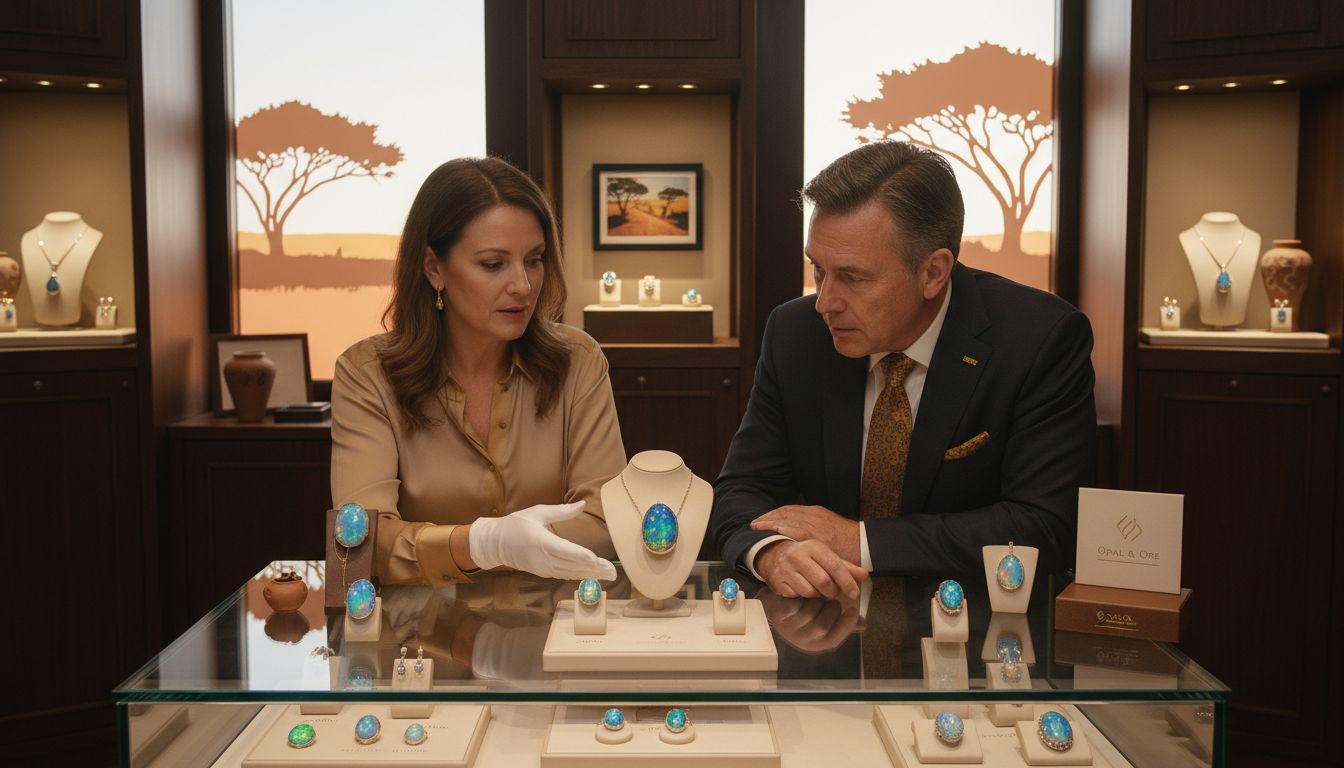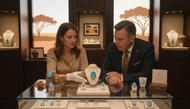Complete Guide to Investing in Opal Jewelry
Posted by AOD on 27th Oct 2025
Complete Guide to Investing in Opal Jewelry

Did you know that a single high-quality Black Opal can sell for over $10,000 per carat? Opal jewelry stands apart because each gemstone displays a rare spectrum of shifting colors, making it unlike any other adornment. For anyone searching for jewelry that is both beautiful and truly unique, understanding opal’s natural artistry and what drives its value can help guide confident and meaningful choices.
Table of Contents
- What Makes Opal Jewelry Unique and Valuable
- Types of Australian Opals and Key Differences
- Factors Influencing Opal Jewelry Value
- Ethical Sourcing and Authenticity Standards
- Risks, Maintenance, and Market Considerations
- Comparing Opals to Other Investment Gemstones
Key Takeaways
| Point | Details |
|---|---|
| Unique Optical Phenomenon | Opals exhibit a remarkable play-of-color, making each stone a unique natural artwork. |
| Value Determinants | Opal value is influenced by factors like brightness, clarity, cut quality, and rarity of color patterns. |
| Types of Australian Opals | Major types include Black, Boulder, Crystal, White, and Matrix Opals, each with distinctive characteristics and value. |
| Ethical Sourcing and Care | It’s essential to verify opal authenticity and practice proper maintenance to protect these delicate gemstones. |
What Makes Opal Jewelry Unique and Valuable
Opals are extraordinary gemstones that set themselves apart through an exceptional optical phenomenon called play-of-color. According to research from gemological experts, opals are formed from hydrated silica and exhibit a mesmerizing light diffraction that creates stunning color spectrums within each individual stone. This means no two opals are exactly alike - each piece is essentially a miniature work of natural art.
The value of opal jewelry is determined by several critical factors that go beyond typical gemstone assessment. As experts in Australian opal research explain, the primary characteristics that influence an opal’s worth include:
- The brightness and brilliance of the color display
- Clarity and minimal internal imperfections
- The quality and precision of the stone’s cut
- Rarity of the specific opal type and color pattern
High-quality opals are distinguished by their vivid, intense colors and strategic cutting techniques that maximize their unique internal light refractions. What makes these gemstones truly special is their dynamic, almost living quality - each stone seems to shift and dance with light, creating a mesmerizing visual experience that transforms ordinary jewelry into wearable art. When you invest in opal jewelry, you’re not just purchasing a gemstone, but acquiring a rare piece of natural beauty with its own distinctive personality.
Types of Australian Opals and Key Differences
Australian opals represent the pinnacle of gemstone diversity, with each type offering unique characteristics that captivate collectors and jewelry enthusiasts. Diving into the world of Australian opal types reveals a fascinating spectrum of geological artistry, primarily categorized into five distinctive varieties.
The most prestigious type is the Black Opal, sourced from Lightning Ridge in New South Wales. Known for its dark body tone and extraordinary color intensity, Black Opal commands the highest value in the market. Complementing this are Boulder Opals from Queensland, which uniquely form within ironstone boulders, creating stunning natural patterns where the host rock becomes an integral part of the stone’s beauty. Crystal Opals offer a different allure with their transparent to semi-transparent composition, allowing light to dance through the stone and enhance its vibrant play-of-color.
Additional Australian opal varieties include White Opals, prevalent in South Australia, characterized by a light body tone and softer color displays. Matrix Opals present another intriguing category, where opal is diffused within the host rock, often treated to accentuate its color characteristics. Each type represents a unique geological narrative, making Australian opals not just gemstones, but miniature landscapes captured within a precious mineral canvas.

Here’s a summary of the main types of Australian opals and their key characteristics:
| Opal Type | Body Tone | Key Source Location | Distinctive Features |
|---|---|---|---|
| Black Opal | Dark, intense | Lightning Ridge, NSW | Strong play-of-color Most valuable |
| Boulder Opal | Dark/light Ironstone matrix |
Queensland | Host rock patterns Natural backing |
| Crystal Opal | Transparent Semi-transparent |
Coober Pedy, NSW Other regions |
Light passes through Bright internal fire |
| White Opal | Light Opaque |
South Australia | Soft colors Widespread |
| Matrix Opal | Diffused Within host rock |
Queensland | Opal in rock pores Often color-treated |
Factors Influencing Opal Jewelry Value
Understanding the intricate factors that determine an opal’s worth is crucial for both collectors and investors. Learn more about the complex valuation of opals, where each stone tells a unique story of geological artistry and rarity.
The primary determinants of opal value revolve around several key characteristics. Brightness and brilliance of the play-of-color stand at the forefront, with opals displaying a full spectrum of vivid colors commanding the highest prices. The color pattern plays a critical role, with rare configurations like the coveted harlequin pattern significantly increasing a stone’s worth. Professional gemologists assess opals based on:
- Number and intensity of colors present
- Clarity and absence of internal imperfections
- Precision and quality of the cut
- Rarity of the color pattern
- Overall visual performance and light reflection
Additionally, the cut of the opal dramatically impacts its value. Cabochon cuts are typically preferred, as they best showcase the stone’s natural play-of-color. Subtle nuances like the shape, symmetry, and how light interacts with the stone can transform an ordinary opal into a remarkable piece of wearable art. Each opal is essentially a miniature canvas, with its value determined by the complex interplay of natural formation, color dynamics, and expert craftsmanship.
Ethical Sourcing and Authenticity Standards
Ethical sourcing in the world of opal jewelry goes far beyond simple purchasing decisions. Understanding the nuances of opal authenticity is crucial for responsible collectors and conscientious buyers who want to ensure their investment supports sustainable practices and genuine craftsmanship.
The landscape of opal authenticity is complex, with multiple categories defining a stone’s true nature. Solid opals represent the gold standard - completely natural gemstones formed over millions of years without any artificial manipulation. In contrast, doublet and triplet opals involve layered constructions, typically combining natural opal with other materials to enhance appearance or reduce cost. Responsible buyers should understand these distinctions:
- Solid opals: 100% natural, single-piece gemstones
- Doublet opals: Natural opal layer attached to a backing material
- Triplet opals: Thin opal layer sandwiched between protective layers
Authenticity in opal sourcing demands transparency about mining practices, environmental impact, and fair labor conditions. The most ethical approach involves tracing an opal’s journey from mine to market, ensuring that each gemstone represents not just natural beauty, but also responsible stewardship of geological resources. Reputable dealers provide detailed documentation about an opal’s origin, type, and any treatments, empowering buyers to make informed and conscientious purchasing decisions.
Risks, Maintenance, and Market Considerations
Investing in opal jewelry requires a nuanced understanding of the unique challenges and potential rewards. Exploring the intricacies of opal investment reveals a complex landscape of care, preservation, and market dynamics that every serious collector must navigate.
Opals are remarkably delicate gemstones that demand specialized maintenance. Environmental sensitivity is their most significant vulnerability, with temperature fluctuations and moisture exposure potentially causing irreparable damage like crazing or structural cracking. Key maintenance considerations include:
- Avoiding direct sunlight and extreme temperatures
- Keeping opals away from harsh chemicals
- Storing in soft, padded environments
- Cleaning only with mild, non-abrasive cloths
- Removing jewelry during physical activities
From a market perspective, opal investment requires careful research and strategic thinking. Different opal types demonstrate varying levels of rarity and appreciation potential, with Black Opals from Lightning Ridge typically commanding the highest values. Collectors should approach opal acquisition as a long-term investment, understanding that market values fluctuate based on color intensity, pattern uniqueness, and overall geological characteristics. Patience and expert consultation are crucial in building a valuable opal portfolio that balances aesthetic beauty with potential financial appreciation.
Comparing Opals to Other Investment Gemstones
Navigating the world of gemstone investments requires a nuanced understanding of each stone’s unique characteristics. Exploring the distinctive investment potential of opals reveals a fascinating landscape that sets these gems apart from more traditional investment stones.
Unlike diamonds or sapphires, opals present a truly extraordinary investment opportunity. Composed of hydrated silica, they possess an unparalleled optical phenomenon called play-of-color that makes each stone a one-of-a-kind treasure. Key differences between opals and other gemstone investments include:
- Extreme variability in value and appearance
- Higher maintenance requirements
- More complex valuation metrics
- Greater dependence on individual stone characteristics
- Unique aesthetic that defies traditional gemstone grading
Where diamonds offer consistent, predictable value, opals present a more artistic investment approach. Black Opals from Lightning Ridge, for instance, can rival or exceed diamond values in specific market conditions. However, potential investors must understand that opal investment demands more expertise, patience, and a willingness to appreciate geological uniqueness. Unlike uniform gemstones, each opal tells a distinct story, making them not just an investment, but a piece of natural art with potential financial appreciation.
Discover the True Value of Investing in Authentic Australian Opal Jewelry
Navigating the complex world of opal investment requires access to genuine, ethically sourced gemstones and expert craftsmanship that brings out each stone’s unique play-of-color and brilliance. This guide reveals the challenges of understanding opal types, maintaining their delicate beauty, and recognizing the precise factors that influence value. If you seek to build a lasting collection that combines rarity with artistic expression then trust in opal jewelry sourced directly from the heart of Australia.

Explore our curated collection at Australian Opal Direct, where every piece tells a story of heritage and natural wonder from Lightning Ridge, Coober Pedy, and Queensland. Take advantage of our premium services including free shipping, 90-day warranties, and custom design options crafted to preserve your investment’s value. Start your opal journey today and own a one-of-a-kind treasure that will captivate for generations. Visit Australian Opal Direct now and experience how authentic opals redefine luxury jewelry with unmatched brilliance and depth.
Frequently Asked Questions
What makes opal jewelry unique compared to other gemstones?
Opal jewelry is unique due to its exceptional optical phenomenon called play-of-color, which creates vibrant, shifting colors within each stone. This individuality makes every opal essentially a one-of-a-kind piece of natural art.
What factors determine the value of opal jewelry?
The value of opal jewelry is determined by brightness and brilliance of color display, clarity, quality of the cut, and the rarity of the opal type and color pattern present in the stone.
How do different types of opals compare in terms of value and appearance?
Black Opals are the most valuable due to their dark body tone and intense colors, while Boulder Opals feature unique patterns from host rock. Crystal Opals are transparent and show light passing through, whereas White Opals tend to have a lighter body tone with subtle colors. Each type has distinct characteristics that influence its market value.
What maintenance is required for opal jewelry to ensure its longevity?
Opal jewelry requires careful maintenance, including avoiding direct sunlight and extreme temperatures, keeping it away from harsh chemicals, and storing it in padded environments. Regular cleaning with mild, non-abrasive cloths also helps preserve the stone’s beauty.
Recommended
- 7 Best Opal Jewelry Tips Every Collector Should Know - Australian Opal Direct
- Comment entretenir bijoux argent opale pour un éclat durable - Australian Opal Direct
- Comment entretenir bijoux argent opale pour préserver leur éclat - Australian Opal Direct
- Guide création bijoux opale : réalisez des pièces uniques - Australian Opal Direct




